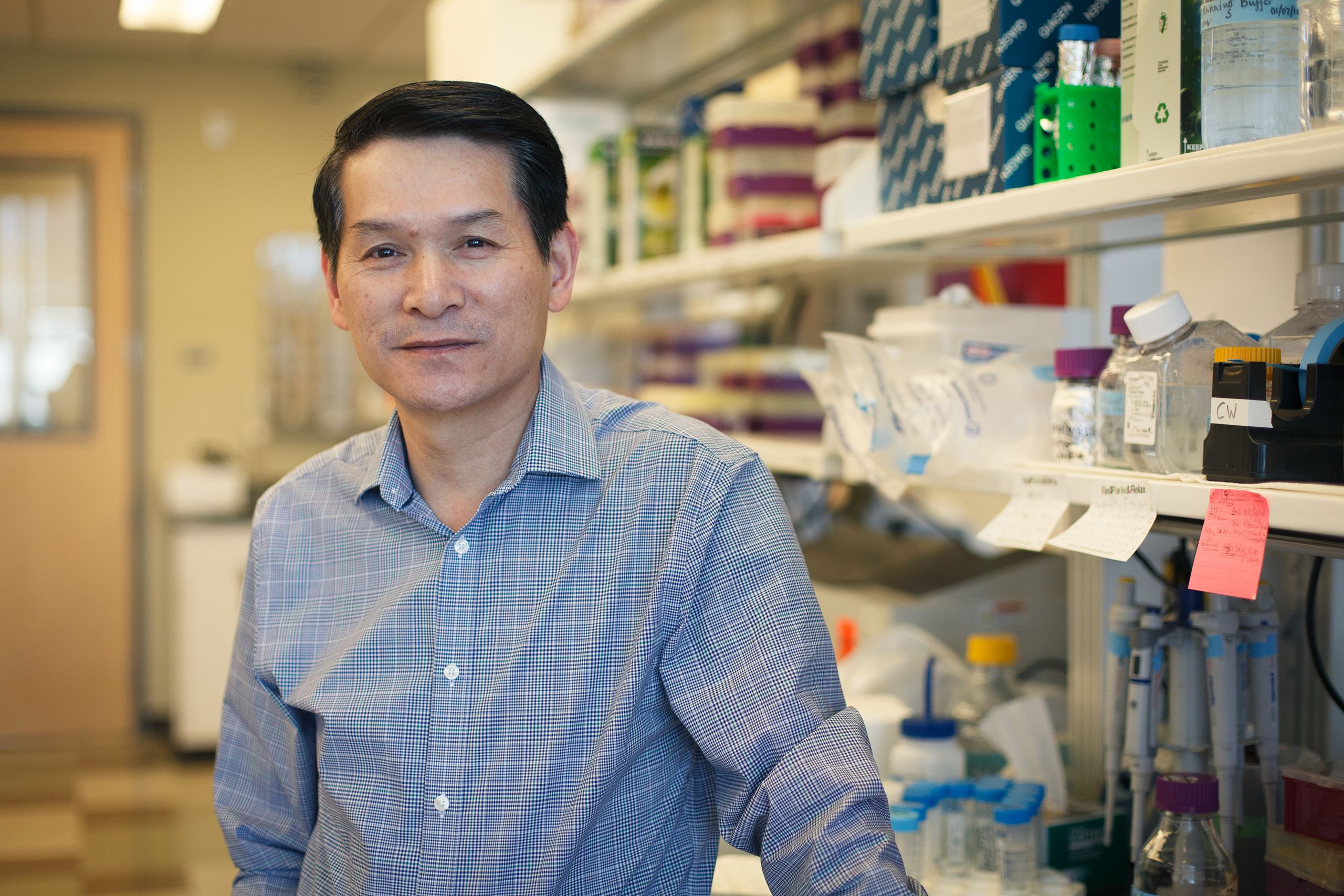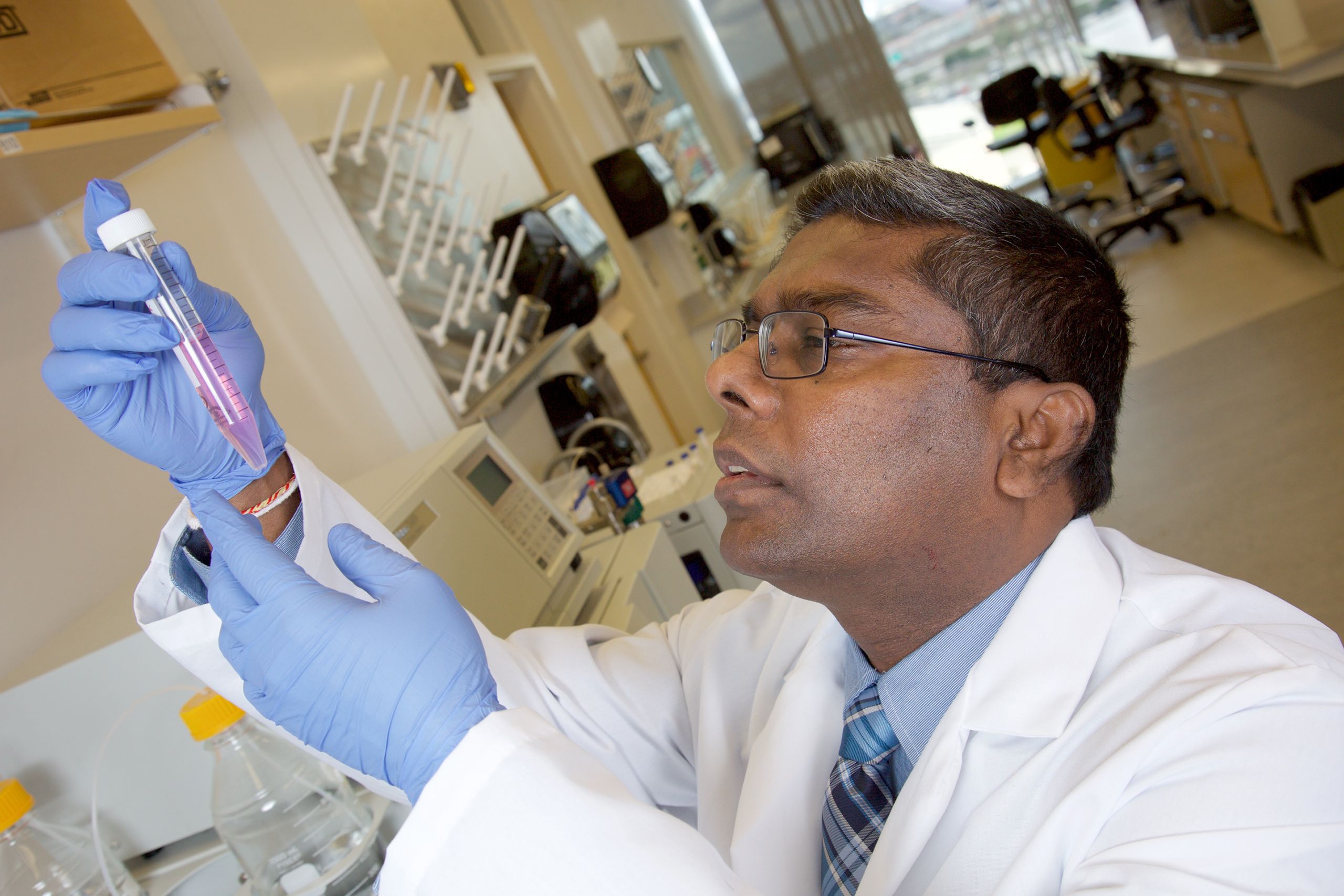Vaccines and Preventive Drugs:
Our Road to Recovery
Meet Three UH Researchers Working on COVID-19 Preventives

Not since the mid-twentieth century, amid the polio epidemic, have vaccines or drug treatment been so widely anticipated as those for COVID-19.
In 1955, when the polio vaccine was licensed, the health outlook for millions of children improved and life returned to normal. Still, not all pandemics have found such resolution. Since the 1980s, more than 70 million people have been infected with the HIV virus; 35 million have died from AIDS; and still no vaccine exists, though a daily drug can help prevent it.
Can researchers develop a safe and effective vaccine or preventive drug for COVID-19? Three University of Houston researchers are working toward that goal.
“One vaccine candidate is extremely promising, as it stimulates much higher neutralizing antibodies than other formulations. The next step is to move this vaccine candidate into clinical testing."
– Shaun Zhang, M.D. Anderson Professor of Biology and Biochemistry

“One vaccine candidate is extremely promising, as it stimulates much higher neutralizing antibodies than other formulations. The next step is to move this vaccine candidate into clinical testing."
– Shaun Zhang, M.D. Anderson Professor of Biology and Biochemistry

EXPLORING VACCINE BY INJECTION
SHAUN ZHANG
Professor of Biology and Biochemistry
As director for the Center for Nuclear Receptors and Cell Signaling, M.D. Anderson Professor of Biology and Biochemistry Shaun Zhang is used to developing new biotherapies and vaccines for unmet needs in cancer and viral infection. Now he’s turned his attention to the greatest unmet medical need before all humankind – a vaccine for COVID-19 – developing three vaccine candidates for injection, which he has evaluated for the production of neutralizing antibodies that can protect cells from infection by SARS-CoV-2 when tested in vitro.
So far, results from the most recent study look good.
“One vaccine candidate is extremely promising, as it stimulates much higher neutralizing antibodies than other formulations. The next step is to move this vaccine candidate into clinical testing,” said Zhang.
Zhang’s vaccine candidates include a subunit vaccine containing either the entire spike protein or the receptor binding portion, which helps the virus enter the target cell, delivered either by DNA formulation or by a herpes simplex virus-based vector.
He is working to improve the formulations to simultaneously enhance the immune responses, simplify the procedure and reduce the cost of preparation.
Gomika Udugamasooriya, associate professor of pharmacological and pharmaceutical sciences, is learning more about how the virus enters the human body.


Gomika Udugamasooriya, associate professor of pharmacological and pharmaceutical sciences, is learning more about how the virus enters the human body.
FINDING A DRUG TO BLOCK ENTRY
GOMIKA UDUGAMASOORIYA Associate Professor of Pharmacological and Pharmaceutical Sciences
To create a drug that could prevent coronavirus, Gomika Udugamasooriya, associate professor of pharmacological and pharmaceutical sciences, first unravels how the virus enters the human body.
“The human entry of coronaviruses depends on first binding of the viral spike proteins to human cellular receptors that basically offer a cellular doorknob,” said Udugamasooriya. “The virus latches onto the specific human cellular receptor, called angiotensin converting enzyme-2, or ACE2, and sneaks inside to replicate itself within the cell to spread throughout the body.”
Following that line, treatments that can block the ACE2 receptor could stop virus entry into the body. “Our approach is to physically ‘guard’ the entry point – the door – so the virus cannot enter,” he said.
Udugamasooriya and collaborator Bin Guo, associate professor of pharmaceutics, are applying their unique cell-screening technology to identify specific synthetic chemical drug leads, called peptoids, that can bind to the ACE2 receptor.
“We have screened 50,000 peptoids and found two compounds that bind to the ACE2 receptor. We showed that our compound interrupts COVID-19 virus S protein recognition of the ACE2 receptor and more importantly, blocks pseudo-virus entry into human cells,” said Udugamasooriya. “Our peptoids do not affect normal functions of the ACE2 receptor such as maintaining blood pressure. Therefore, our compounds indeed can bind and ‘guard the ACE2 receptor,’ as we hypothesized initially, without disturbing our normal functions in the body.”
Udugamasooriya is exploring nasal spray or eye drop type product developments and partnering with industry.
Navin Varadarajan, M.D. Anderson Professor of Chemical and Biomolecular Engineering, is testing inhalation vaccines. Think FluMist® for COVID-19.

TESTING INHALATION VACCINES
NAVIN VARADARAJAN Professor of Chemical and Biomolecular Engineering
Navin Varadarajan, M.D. Anderson Professor of Chemical and Biomolecular Engineering, is developing inhalation vaccines. Think FluMist® for COVID-19.
“For airborne pathogens, the nasal compartment is the first point of defense that needs to be breached,” said Varadarajan. “Mucosal immunity and vaccines are fundamentally important for a wide range of pathogens, including influenza, severe acute respiratory syndrome coronavirus (SARS-CoV) and the current SARS-CoV-2.” Still, he said, nasopharyngeal immunity is understudied.
Varadarajan is using the spike protein, which helps the virus enter the target cell, and is the major target for neutralizing antibodies as it binds to the ACE 2 cellular receptor for virus entry. He prefers using proteins because of their ability to induce strong immune responses, flexibility and scalability, and the absence of infectious particles.
Varadarajan notes several considerations of pivotal importance in designing an efficient, but safe mucosal vaccine.
“As with any vaccine, a variety of factors determine their efficacy, including the antigen used for electing a response, the adjuvants and immunomodulators, the efficient delivery of the antigen to appropriate target cells and the route of vaccination,” he said. Varadarajan is collaborating with Xinli Liu, associate professor of pharmaceutics, who is synthesizing a new liposomal adjuvant.